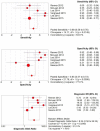Does stroke volume variation predict fluid responsiveness in children: A systematic review and meta-analysis
- PMID: 28498858
- PMCID: PMC5428964
- DOI: 10.1371/journal.pone.0177590
Does stroke volume variation predict fluid responsiveness in children: A systematic review and meta-analysis
Abstract
Objective: Stroke volume variation (SVV) is a reliable predictor of fluid responsiveness in adult patients. However, the predictive value of SVV is uncertain in pediatric patients. We performed the first systematic meta-analysis to evaluate the diagnostic value of SVV in predicting fluid responsiveness in children.
Methods: PUBMED, EMBASE, and Cochrane Central Register of Controlled Trials were searched up to December 2016. Original studies assessing the diagnostic accuracy of SVV in predicting fluid responsiveness in children were considered to be eligible. A random-effects model was used to calculate pooled values of sensitivity, specificity and diagnostic odds ratio with 95% CI. The summary receiver operating characteristic curve was estimated and area under the curve was calculated. Quality of the studies was assessed with the QUADAS-2 tool.
Results: Six studies with a total of 279 fluid boluses in 224 children were included. The analysis demonstrated a pooled sensitivity of 0.68 (95% CI,0.59-0.76), pooled specificity of 0.65 (95% CI, 0.57-0.73), pooled diagnostic odds ratio of 8.24 (95% CI, 2.58-26.30), and the summary area under the summary receiver operating characteristic curve of 0.81. However, significant inter-study heterogeneity was found (p<0.05, I2 = 61.3%), likely due to small sample size and diverse study characteristics.
Conclusions: Current evidence suggests that SVV was of diagnostic value in predicting fluid responsiveness in children under mechanical ventilation. Given the high heterogeneity of published data, further studies are needed to confirm the diagnostic accuracy of SVV in predicting fluid responsiveness in pediatric patients.
Conflict of interest statement
Figures



Similar articles
-
Accuracy of stroke volume variation in predicting fluid responsiveness: a systematic review and meta-analysis.J Anesth. 2011 Dec;25(6):904-16. doi: 10.1007/s00540-011-1217-1. Epub 2011 Sep 4. J Anesth. 2011. PMID: 21892779
-
Respiratory variation in aortic blood flow peak velocity to predict fluid responsiveness in mechanically ventilated children: a systematic review and meta-analysis.Paediatr Anaesth. 2016 Jan;26(1):37-47. doi: 10.1111/pan.12803. Epub 2015 Nov 6. Paediatr Anaesth. 2016. PMID: 26545173
-
Dynamic changes in arterial waveform derived variables and fluid responsiveness in mechanically ventilated patients: a systematic review of the literature.Crit Care Med. 2009 Sep;37(9):2642-7. doi: 10.1097/CCM.0b013e3181a590da. Crit Care Med. 2009. PMID: 19602972
-
Ultrasonographic measurement of the respiratory variation in the inferior vena cava diameter is predictive of fluid responsiveness in critically ill patients: systematic review and meta-analysis.Ultrasound Med Biol. 2014 May;40(5):845-53. doi: 10.1016/j.ultrasmedbio.2013.12.010. Epub 2014 Feb 2. Ultrasound Med Biol. 2014. PMID: 24495437
-
A systematic review of pulse pressure variation and stroke volume variation to predict fluid responsiveness during cardiac and thoracic surgery.J Clin Monit Comput. 2017 Aug;31(4):677-684. doi: 10.1007/s10877-016-9898-5. Epub 2016 Jun 15. J Clin Monit Comput. 2017. PMID: 27306799
Cited by
-
Prediction model for patients with acute respiratory distress syndrome: use of a genetic algorithm to develop a neural network model.PeerJ. 2019 Sep 16;7:e7719. doi: 10.7717/peerj.7719. eCollection 2019. PeerJ. 2019. PMID: 31576250 Free PMC article.
-
Predictive Value of the Respiratory Variation in Inferior Vena Cava Diameter for Ventilated Children With Septic Shock.Front Pediatr. 2022 Jul 7;10:895651. doi: 10.3389/fped.2022.895651. eCollection 2022. Front Pediatr. 2022. PMID: 35874570 Free PMC article.
-
Increasing Cardiovascular Data Sampling Frequency and Referencing It to Baseline Improve Hemorrhage Detection.Crit Care Explor. 2019 Oct 30;1(10):e0058. doi: 10.1097/CCE.0000000000000058. eCollection 2019 Oct. Crit Care Explor. 2019. PMID: 32166238 Free PMC article.
-
Determining pediatric fluid responsiveness by stroke volume variation analysis using ICON® electrical cardiometry and ultrasonic cardiac output monitor: A cross-sectional study.Int J Crit Illn Inj Sci. 2020 Jul-Sep;10(3):123-128. doi: 10.4103/IJCIIS.IJCIIS_87_18. Epub 2020 Sep 22. Int J Crit Illn Inj Sci. 2020. PMID: 33409126 Free PMC article.
-
Prediction of Fluid Responsiveness by Stroke Volume Variation in Children Undergoing Fontan Operation.Biomed Res Int. 2020 Nov 7;2020:2595960. doi: 10.1155/2020/2595960. eCollection 2020. Biomed Res Int. 2020. PMID: 33224977 Free PMC article.
References
-
- Rosenberg AL, Dechert RE, Park PK, Bartlett RH, Network NNA. Review of a large clinical series: association of cumulative fluid balance on outcome in acute lung injury: a retrospective review of the ARDSnet tidal volume study cohort. Journal of intensive care medicine. 2009;24(1):35–46. 10.1177/0885066608329850 - DOI - PubMed
Publication types
MeSH terms
LinkOut - more resources
Full Text Sources
Other Literature Sources

